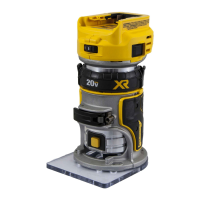12
ENGLISH
ASSEMBLY AND ADJUSTMENTS
WARNING: To reduce the risk of serious personal
injury, turn tool off and disconnect battery pack
before making any adjustments or removing/
installing attachments or accessories. An accidental
start-up can causeinjury.
WARNING: Use only DeWALT battery packs andchargers.
Inserting and Removing the Battery Pack
from the Tool (Fig. C)
NOTE: Make sure your battery pack
1
is fullycharged.
To Install the Battery Pack into the Tool Handle
1. Align the battery pack
1
with the rails inside the tool’s
handle (Fig. C).
2. Slide it into the handle until the battery pack is firmly seated
in the tool and ensure that you hear the lock snap intoplace.
To Remove the Battery Pack from the Tool
1. Press the release button
2
and firmly pull the battery pack
out of the toolhandle.
2. Insert battery pack into the charger as described in the
charger section of thismanual.
Fuel Gauge Battery Packs (Fig. C)
Some DeWALT battery packs include a fuel gauge which
consists of three green LED lights that indicate the level of
charge remaining in the batterypack.
To actuate the fuel gauge, press and hold the fuel gauge
button
46
. A combination of the three green LED lights will
illuminate designating the level of charge left. When the level
of charge in the battery is below the usable limit, the fuel gauge
will not illuminate and the battery will need to berecharged.
NOTE: The fuel gauge is only an indication of the charge left on
the battery pack. It does not indicate tool functionality and is
subject to variation based on product components, temperature
and end-userapplication.
Bit Installation and Removal (Fig.D)
To Install the Bit
1. Remove the motor unit from the base unit. Refer to
Removing the Motor from the Fixed Base or Removing
the Motor from the Plunge Base (ifneeded).
2. Clean and insert the round shank of the desired router bit
into the loosened collet as far as it will go and then pull it
out about 1.6mm.
3. Depress the spindle lock button
7
to hold the spindle shaft
in place while turning the collet nut
23
clockwise with the
wrenchprovided.
NOTE: The unit is equipped with multiple spindle lock
detents allowing an optional "manual ratchet" method of
tightening thebit.
To tighten with the "manual ratchet" method:
a. Without removing the wrench from the collet nut
23
,
release pressure on the spindle lock button
7
.
b. With the wrench still on the collet nut, reverse the
tightening direction to reset the wrenchposition.
c. Depress the spindle lock button again and turn the
wrenchclockwise.
d. Repeat the procedure until the collet nut reaches
desiredtightness.
NOTICE: Avoid possible damage to the collet. Never
tighten the collet without abit.
To Remove the Bit
1. Remove the motor unit from the base unit (refer to
Removing the Motor from the Fixed Base or Removing
the Motor from the Plunge Base.
2. Depress the spindle lock button
7
to hold the spindle shaft
in place while turning the collet nut
23
anticlockwise with
the wrenchprovided.
To loosen using the "manual ratchet" method:
1. Without removing the wrench from the collet nut
23
,
release pressure on the spindle lock button
7
.
2. With the wrench still on the collet nut
23
, reverse the
loosening direction to reset the wrenchposition.
3. Depress the spindle lock button
7
again and turn the
wrenchanticlockwise.
4. Repeat the procedure until the collet nut
23
is loose and
the bit can beremoved.
Collets
NOTE: Never tighten the collet without first installing a router
bit in it. Tightening an empty collet, even by hand, can damage
thecollet.
To change collet sizes, unscrew the collet assembly as described
above. Install the desired collet by reversing the procedure.
The collet and the collet nut are connected. Do not attempt to
remove the collet from the colletnut.
Locking Lever Adjustment (Fig.E)
Excessive force should not be used to clamp the locking lever.
Using excessive force may damage thebase.
When the locking lever is clamped, the motor should not move
in thebase.
Adjustment is needed if the locking lever will not clamp without
excessive force or if the motor moves in the base afterclamping.
To adjust the locking lever’s clamping force:
1. Open the locking lever
12
(fixed base) or
40
(plungebase).
2. Using a hex wrench turn locking lever adjustment screw
24
in smallincrements.Turning the screw clockwise tightens
the lever, while turning the screw anticlockwise loosens
thelever.
Centreing the Subbase (Fig.A, F1–F3)
If you need to adjust, change, or replace a subbase, a centreing
tool is recommended. The centreing tool consists of a cone and
apin.
To adjust a subbase, follow the stepsbelow.
Figure F1 shows adjusting the D-shaped subbase on the
fixed base.

